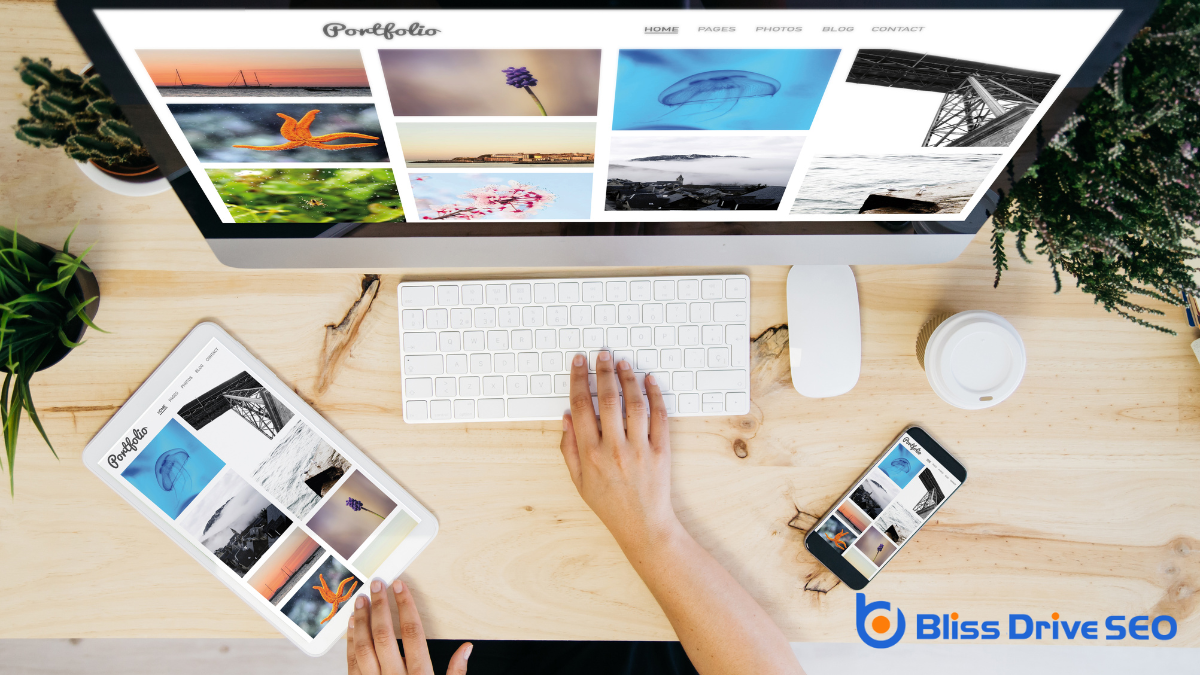Digital Marketing Services
Learn More About Us

Starting freelance web design requires more than just technical skills; it's about strategically positioning yourself in a competitive market. You might wonder how to stand out and attract clients. Begin by honing your expertise in fundamental tools, and don't forget the importance of a professional portfolio that reflects your unique style. But how do you decide on pricing and nicheA specific segment of the market targeted by affiliates to promote products or services., or even find those first vital clients? Each step is significant, and knowing how to navigate them can make or break your freelance journey. Let's explore these pivotal aspects and reveal the potential for success in web design freelancing.
Before diving into freelance web design, it's vital to evaluate your skills and the tools at your disposal. Start by taking a critical look at your current abilities. Are you proficient in HTML, CSS, and JavaScript? These are fundamental skills every web designer needs. If you're not confident yet, consider online tutorials or courses to bolster your knowledge. Familiarize yourself with important software like Adobe Creative Suite or Sketch for design tasks.
Next, assess your problem-solving abilities and creativity. Web design isn't just about making things look pretty; it's about crafting user-friendly experiences. Practice by designing mock websites or revamping existing ones to sharpen your skills.
Once you've evaluated your skills, it's time to take stock of your tools. A reliable computer, high-speed internet, and the right software are vital. Make sure your hardware can handle design software smoothly to prevent unnecessary frustration.
Don't forget about online tools like WordPress or Webflow, which can simplify the design process and expand your capabilities.

With your skills and tools assessed, the next step is to build a strong portfolio that showcases your expertise and creativity. This collection of work is your chance to make a great first impressionWhen an ad is displayed on a user’s screen. on potential clients.
Start by selecting your best projects, those that highlight your unique style and technical abilities. It's essential to include a variety of work that demonstrates your versatility in design, such as responsive websites, e-commerce platformsSoftware solutions that allow businesses to create and manage online stores, such as Shopify, WooCom..., or personal blogs.
When organizing your portfolio, make it easy for visitors to navigate. Categorize your projects logically and provide concise descriptions. Explain the challenges you faced and how you solved them. Clients appreciate understanding the thought process behind your designs, so be transparent about your role in each project.
Visuals are key. Use high-quality images or even interactive elementsElements that require user interaction, such as buttons, forms, and sliders. to give visitors a clear sense of your work. You might consider creating a dedicated website for your portfolio, showcasing your web design skills firsthand.
Don't forget to include contact information, encouraging potential clients to reach out. Remember, your portfolio is a living document—keep it updated with your latest and most impressive work to continually attract attention.
Finding your niche in freelance web design is essential for standing out in a crowded market. Instead of trying to be a jack-of-all-trades, focus on what you're passionate about and where your strengths lie. Maybe you love designing e-commerce sites, or perhaps you've got a knack for creating sleek portfolios for artists. Whatever it is, honing in on a specific area lets you showcase your expertise, making you more appealing to potential clients who need exactly what you offerThe specific product or service being promoted by affiliates..
Start by evaluating your skills and interests. Ask yourself what types of projects excite you and what industries you're familiar with. Consider your past experiences; they might reveal a pattern that points you toward your niche.
Once you've identified a few possibilities, research the demand for those services. Are there enough potential clients in that niche? Is there significant competition?
Defining your niche doesn't limit you; it focuses your marketing efforts and helps you develop specialized skills. As you establish yourself as an expert in a specific area, you'll attract clients who value your unique expertise, leading to more satisfying projects and potentially higher earnings.
To set your rates effectively, start by determining an hourly rate that reflects your skills and experience.
Evaluate the complexity of each project to guarantee your pricing aligns with the effort required.
Additionally, consider market demand to stay competitive while making sure your rates are sustainable.
Setting your hourly rate is a crucial step in establishing your freelance web design business. It's important to understand that your rate reflects your skills, experience, and the value you bring to your clients.
Start by researching the market rate for web designers with similar expertise in your area. This gives you a baseline and helps guarantee you're competitive while not undervaluing your work.
Consider your experience level. If you're just starting, you might set your rates on the lower end of the spectrum but don't sell yourself short. As you gain confidence and a portfolio, you can gradually increase your rates.
Factor in your business expenses, such as software, equipment, and taxes. Your hourly rate should cover these costs and provide you with a sustainable income.
Don't forget to account for non-billable hours. Time spent on marketing, client communication, and administrative tasks won't be directly paid, so they should be factored into your rate.
Finally, trust your judgment. If a rate feels too low, it likely is. Remember, your skills and time are valuable, and your rate should reflect that.
Evaluating project complexity is essential when setting your rates as a freelance web designer. Complexity directly affects the time and effort you'll invest in a project, which should reflect in your pricing.
Start by examining the project's scope: Is it a simple landing pageThe web page a user is directed to after clicking on an affiliate link, optimized for conversions. or a full-fledged e-commerce site? Each type presents its own challenges and demands different skill levels.
Consider the specific features requested. A project requiring advanced functionalities like custom databases, user authentication, or third-party integrations will naturally be more complex.
Don't forget to review the client's expectations regarding design aesthetics and user experience. High-end, custom designs require more creativity and time.
Next, think about the resources and tools involved. Complex projects might need specialized software or collaboration with other professionals, which can add layers to the process.
Also, analyze the client's tech-savviness. A client who's less familiar with technical aspects might need more guidance, increasing project complexity.
Finally, reflect on your own experience and expertise. More experience means you can handle complexity more efficiently, affecting how you price your work.
Understanding market demand is vital when setting your rates as a freelance web designer. Knowing what clients are willing to pay helps you price your services competitively while guaranteeing you earn a fair income.
Start by researching the going rates for web design in your area or niche. Look at what other freelancers with similar skills and experience charge. This information provides a baseline for your pricing strategy.
Consider the demand for specific skills or services you offer. If you specialize in a high-demand area like e-commerce or mobile-responsive design, you can justify higher rates. Conversely, if you're entering a saturated market, you might need to be more flexible with your pricing until you establish a reputation.
Stay informed about industry trends and market fluctuations, as these can impact demand and client budgets. Regularly reassessing your rates guarantees they align with current market conditions and your evolving expertise.
Don't undervalue your work. While competitive pricing is important, it's equally significant to maintain rates that reflect the quality and value you provide.

Crafting a solid business plan is a crucial step in launching your freelance web design career. It might sound intimidating, but think of it as a roadmap that guides your decisions and helps you stay focused. A well-thought-out plan lays the foundation for success and helps you anticipate potential challenges.
Start by defining your goals. Are you aiming for part-time work, or are you planning to immerse yourself full-time? Setting clear objectives will pave the way for growth.
Next, outline your target market. Who are your ideal clients, and what industries do they belong to? This helps you tailor your services to meet their needs effectively.
Consider these essential components when creating your business plan:
To find your first clients, start by reaching out to your personal network and letting them know about your new venture.
Utilize online platforms like LinkedInA professional networking site used for career and business networking. and freelance websites to showcase your skills and connect with potential clients.
Consider offering introductory discounts to attract interest and build your portfolio.
Building a freelance web design business often starts with leveraging your personal network to find your first clients. Your friends, family, and acquaintances can be invaluable in helping you get your foot in the door.
Begin by letting them know about your new venture and the services you offer. You'd be surprised how often people need web design services or know someone who does.
To effectively tap into your network, consider these strategies:
Relying on your personal network isn't just about getting your first clients; it's also about building lasting relationships.
When people know you personally, they're more likely to trust your work and recommend you to others.
After tapping into your personal network, broadening your reach through online platforms can greatly increase your chances of landing your first freelance web design clients.
Platforms like Upwork, Fiverr, and Freelancer offer a great starting point. They connect you with potential clients actively seeking web design services. To stand out, create a compelling profile that highlights your skills, experience, and unique design approach. Be sure to include a portfolio showcasing your best work, even if it's just personal or mock projects to start.
LinkedIn is another powerful tool you shouldn't overlook. It's not just a networking site; it's a platform where businesses search for freelancers. Regularly update your profile, share insights, and engage with industry-specific groups to catch the eye of potential clients.
Don't forget about social media platforms like Instagram and Behance, which are visually driven and perfect for web designers. Share snapshots of your designs and process insights, and interact with followers to build a community around your work.
Remember to stay active and responsive on these platforms. Clients appreciate prompt communication and professionalism, which can make you more appealing as a freelancer.
Keep refining your online presence, and you'll start attracting clients in no time.
One effective strategy to attract your first freelance web design clients is offering introductory discounts. By doing so, you create a sense of urgency and appeal to potential clients who may be hesitant to try out a new designer.
This tactic not only helps you build your client base but also allows you to showcase your skills and gain valuable experience. When crafting your discount offer, consider the following approaches:
Effectively managing projects is vital for freelance web designers aiming to deliver quality work on time. Start by setting clear goals and expectations with your clients. Discuss timelines, deliverables, and any potential obstacles right from the beginning. This helps avoid misunderstandings and guarantees everyone's on the same page.
Use project management tools like Trello or Asana to keep track of tasks and deadlines. These platforms allow you to break down projects into manageable parts and monitor progress at a glance. Regularly update your clients on the project's status. It keeps them informed and builds trust, showing you're committed to transparency.
Time management is essential. Allocate specific hours for each task and stick to your schedule. Consider using time-tracking software to understand where your time goes and adjust accordingly. Prioritize tasks based on deadlines and complexity to maintain a steady workflow.
Communication is key. Keep lines open via emails or scheduled calls to address questions or feedback promptly. This proactive approach prevents small issues from escalating into bigger problems.

As you refine your project management skills, it's equally important to market your services effectively to attract new clients. Your ability to showcase what you can offer is vital in a competitive freelance web design market.
Start by creating an engaging online portfolio that highlights your best work. This portfolio serves as a visual resume and can be the deciding factor for potential clients.
Consider these strategies to enhance your marketing efforts:
Starting a freelance web design career is all about taking action and staying proactive. You've got the skills and the tools—now put them to work. Build a standout portfolio and find your niche to differentiate yourself. Set competitive rates and create a solid business plan. Leverage your network to find your first clients and keep them happy with efficient project management. Market your services consistently, and you'll be on the path to success in no time.
